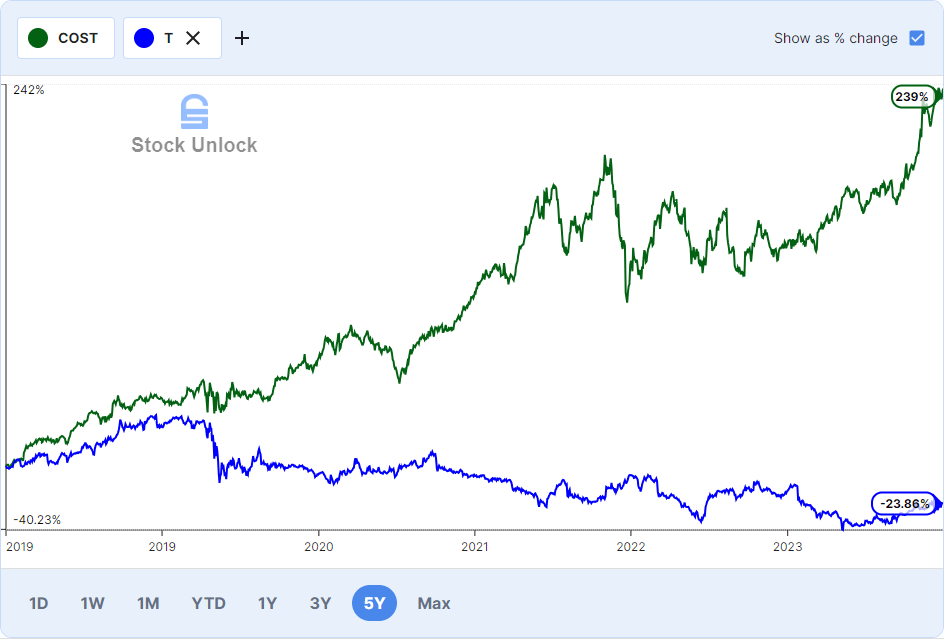The dividend investing strategy is one of the strategies currently adopted by retail investors. Understanding the nuances of this approach is essential, as it comes with its own set of advantages and drawbacks.
Table of contents:
Pros of Dividend Investing
1. Steady Income Flow
Everyone likes seeing cash coming into the balance, and dividend payouts can serve as a consistent income stream. These periodic cash distributions create a stable financial foundation, allowing for predictable financial planning.
Real-life examples showcase stalwart companies like Johnson & Johnson (JNJ) and Procter & Gamble (PG), whose commitment to dividend payments has stood the test of economic turbulence. To make it clear, let’s assume you invested $10,000 in Procter & Gamble 10 years ago. Excluding the insane stock performance, you received $4,238 in dividends just from holding onto it.
| Invested | 10000$ |
| Share price 10 years ago | 79$ |
| Shares bought | 127 |
| Yearly dividend payout | 2.57$ |
| Growth year-over-year | 4% |
| 10-year dividend received | $4237.99 |
2. Dividend Reinvestment
The mechanics of dividend reinvestment are a big plus in the world of dividend investing. It’s like making your money work harder for you. Instead of pocketing the dividends, you use them to buy more shares. This sets off a kind of snowball effect, making your money grow faster and faster over time. Think of it like our earlier example with Procter and Gamble. By putting your dividends back into more shares, you not only grow your collection of stocks but also get more money in dividends. It’s a smart move that keeps your money growing steadily over the years.
3. Historical Stability
Exploring how a company consistently pays dividends connects to its stability. When companies regularly share profits with investors, it often means they’re financially sound. This stability shines, especially when the market gets unstable. Many dividend investors see their stocks as a reliable income source, making them likely to stick around even when things get tough.
4. Inflation Resilience
Dividend stocks are widely recognized as a reliable way to protect your money from losing value due to rising prices. When companies offer a dividend yield that surpasses the inflation rate, investors gain a valuable opportunity to not only safeguard their wealth but also outpace the erosive effects of inflation.
Example: in the US average inflation rate was sitting at ~3.2%, stocks like Exxon Mobil Corp(XOM) with a yield of 3.68%, United Parcel Service Inc(UPS) yielding ~4.07% and many others provided a yield of that outpace inflation.
Nevertheless, picking the stocks only by yield can be a risky endeavor. Because high yields can sometimes be indicative of a company facing financial challenges or uncertainties.
Cons of Dividend Investing
1. Market Volatility
Dividend-paying stocks often come with investors’ expectations regarding both dividend payouts and dividend growth. However, if a business faces financial challenges or economic downturns, it may be forced to cut or suspend dividend payments to preserve capital, resulting in a reduction in expected income for investors. Such events can lead to significant volatility.
Example: consider Intel Corp (INTC). The company was a consistent dividend payer; however, when it faced issues and was forced to cut its dividend, the share price experienced a decline. The stock’s value fell after the company announced worse-than-expected earnings for consecutive quarters, culminating in the decision to reduce the dividend at the end.

2. Limited Growth Potential
Opting to invest for a steady income from dividends may constrain the overall growth of your portfolio. Companies that have consistently paid dividends for decades are likely to be mature and have plateaued in their growth story. Consequently, you should not anticipate substantial capital appreciation beyond the dividend income.
Illustration: I searched for ‘top dividend-paying stocks’ and found an article by Morningstar. The first four stocks on the list were Exxon Mobil (XOM), Verizon Communications (VZ), PepsiCo (PEP), and Altria Group (MO). Now, let’s compare their share price performance, excluding dividends.
| Asset | Performance over a decade |
| S&P 500 | 165% |
| PEP | ~105% |
| MO | ~17% |
| XOM | ~15% |
| VZ | ~(-10%) |
As we can observe, a simple strategy of investing in an index shows better growth in terms of share price appreciation.
3. Tax Implications
The taxation of dividend income adds a layer of complexity to dividend investing. The percentage varies from country to country, making it crucial to understand the tax implications for optimizing overall returns.
Strategies aimed at tax efficiency in dividend investing may include exploring tax-advantaged accounts that offer investors significant tax benefits. However, in regions where such tax-advantaged accounts are unavailable, investors should be cautious when building a dividend portfolio.
For instance, in my personal investment experience in the Czech Republic, where the tax rate is 15%, and tax-sheltered accounts aren’t offered. I account for taxation events each time I invest in dividend-paying stock.
4. Capital Distribution Strategy
The decision to implement a capital distribution strategy through dividend payments often signals a company’s acknowledgment of its limited opportunities to reinvest capital back into the business. Companies facing challenges in identifying profitable investment areas within their operations, or those operating in mature industries with limited growth prospects, may opt for a dividend distribution strategy.
Investor’s Perspective: understanding the motivations behind a company’s dividend policy is essential. It can serve as an indicator of the company’s growth trajectory, financial health, and management’s confidence in future business prospects.
Real-Life Examples
Good Case: Costco Wholesale Corp(COST)
Costco stands out as an excellent illustration of effective dividend allocation. Maintaining a relatively modest dividend yield, the company places a strong emphasis on achieving rapid dividend growth. Capital is strategically reinvested, fueling expansion, innovation, and operational enhancements. What sets Costco apart is its commitment to rewarding shareholders with occasional special dividends when surplus cash accumulates. This approach allows Costco to reward shareholders both through dividends and share price performance.
Bad Case: AT&T Inc(T)
AT&T has been a subject of discussion regarding its capital allocation decisions, despite its reputation as a dividend aristocrat with a historically high yield. A substantial debt load, attributed to acquisitions and a capital-intensive business model, has limited the company’s financial flexibility. Consequently, the company faces two main challenges—dividend payments and debt repayment—that significantly deduct from earnings. The aftermath of these transactions often leaves insufficient funds to cover the company’s spending, prompting AT&T to resort to issuing more debt, as cutting dividends would risk losing its coveted ‘dividend aristocrat’ status.
Stock performance over the past 5 years.

Conclusion
In concluding this comparison, I characterize it as a trade-off: sacrificing potential return for a stable income stream. If you are seeking higher returns or a simpler investment strategy, dividend investing may not be the right fit for you.
However, if you decide to stick with this strategy, here are a couple of points to consider:
- Always assess the business, not just the dividends it pays.
- Be efficient in taxation; seek the assistance of a tax advisor for guidance.
- Don’t solely focus on dividend yield; stocks that appreciate in price and show consistent dividend growth tend to perform better over the long term.
In my view, dividend investing can be successful, particularly when focusing on companies with a strong emphasis on dividend growth. For more information on this approach, you can explore the article provided here.

Leave a Reply